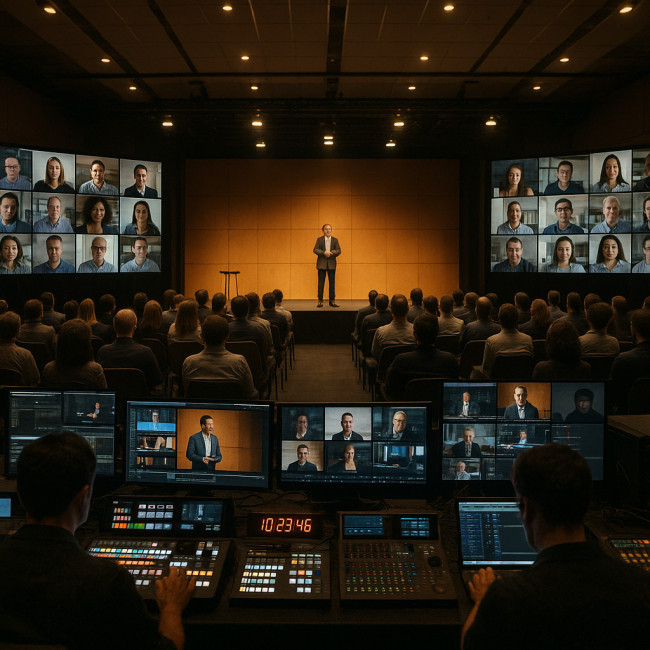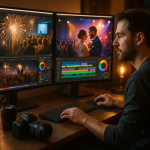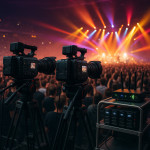Hybrid events: synchronising on-site and streaming footage without stress
Running a hybrid event means juggling two audiences at once – those in the room and those behind their screens. This guide shows you how to synchronise on-site and streaming footage seamlessly, so every attendee enjoys a polished, energising experience.
Why flawless synchronisation matters

Hybrid events live or die on timing. A three-second delay between projector visuals and livestream audio feels small, yet it breaks applause, dulls speaker jokes and tanks post-event survey scores. When you master synchronisation, you boost engagement metrics, average watch-time, sponsorship value and, ultimately, repeat bookings.
Top engagement wins that stem from perfect sync
- Higher average watch duration (up to 27 % in recent tech-conference studies).
- More live chat interaction because questions align with on-stage moments.
- Smoother post-event edits – less time hunting for clapperboard peaks.
Pre-production checklist: set the stage for smooth hybrid events
Great synchronisation starts weeks before the first cable is taped to the floor. Follow this checklist and you'll slash on-site stress.
- Unify timecode strategy. Decide whether you'll embed SMPTE LTC, NTP or camera manufacturer-specific timecode across every recording device. Stick to one.
- Choose low-latency protocols. WebRTC or SRT typically outperform RTMP by 50–100 ms. Your choice affects every frame.
- Map venue network paths. Segment an isolated VLAN for production traffic to avoid attendee Wi-Fi spikes.
- Create a redundancy grid. Mirror encoders, record to camera and to cloud. If one feed drifts, the backup keeps rolling. Dive deeper into contingencies with gear redundancy strategies for high-stakes events.
- Script “sync points”. Plan moments (e.g., speaker countdown, unified hand clap) every 30 minutes so editors can realign multi-camera angles later.
On-site capture workflow that keeps frames aligned
Once doors open, your crew needs muscle-memory routines that lock timing from lens to livestream.
1. Jam-sync cameras
Connect all camera bodies to a single master clock. Most modern cinema rigs accept external timecode via BNC. Keep a pocket generator for unexpected handheld DSLRs – it's a lifesaver.
2. Sync audio at the console
Digital mixing desks often provide word clock or AES3 feeds. Route one to the master clock so claps match mouth movement, preventing annoying lip-sync drift for virtual viewers.
3. Implement live compositing
Software switchers such as vMix or OBS capture NDI sources with embedded timestamps. This lets you overlay slides on camera feeds in real time, minimising the risk of last-minute export errors.
4. Monitor with dual scopes
Assign a technician to watch waveform and audio phase meters. They'll spot hiccups faster than relying on human eyes alone.
Need insurance and crew safety advice while you streamline sync? Read the companion guide on live-shoot risk management.
Low-latency streaming: protocols, encoders and buffers
The streaming side introduces delay. Your job is to tame it.
| Protocol | Typical end-to-end latency | Best use case |
|---|---|---|
| HDMI direct feed | 5 ms | On-site screens |
| WebRTC | ≈ 50 ms | Interactive workshops, Q&A |
| NDI over LAN | 150 ms | Multi-room venues |
| SRT over WAN | 200 ms | Cross-city contribution feeds |
| RTMP CDN | 250 ms | Mass-scale public streams |
Encoder settings that matter most
- CBR over VBR. Constant bit-rate minimises sudden buffer spikes.
- GOP length ≤ 1 s. Shorter keyframes quicken recoveries after packet loss.
- Audio ahead by 20 ms. Many players buffer video first; sending audio a hair early keeps mouths matching words.
To polish the interactive layer, insert chapters or hotspots later. Learn how in our hotspot engagement tutorial.
Post-production: deliver on-demand versions without headaches
Even when live sync is tight, small drifts creep in over a two-hour keynote. Here is a friction-free polishing routine.
- Import all ISOs and program feed into a timeline using the same frame rate and audio sample rate.
- Run a multi-camera sync by timecode. If a DSLR lacked jam-sync, use audio waveforms for that track.
- Check every pre-planned “sync point”. Adjust with slip edits rather than blade cuts to keep underlying timecode intact.
- Render proxies for fast client review. When they approve, relink full-resolution media and export.
Need a complete roadmap from brief to final cut? Bookmark this workflow checklist.
Visualising latency sources
Source : Streaming Media Magazine
Common pitfalls and quick fixes
- Wi-Fi reliance: Hard-wire every production PC. Use Wi-Fi only for attendee Q&A tablets.
- Ignoring firmware updates: An outdated switcher can introduce frame drops. Schedule updates one week before show day, never the night before.
- Mismatched frame rates: Shooting 29.97 fps and streaming 25 fps causes silent drift. Align both at 25 fps for Europe or 30 fps for North America.
- Under-resourced crew: One operator can't handle both chat moderation and technical sync. Hire an additional remote tech. Need to secure bigger gigs? Check local SEO tactics for videographers.
Budget snapshot: DIY vs managed hybrid solutions
| Line item | DIY setup | Managed provider | Pro tip |
|---|---|---|---|
| Timecode generator | €350 one-off | Included | Rent if you run < 4 events a year |
| Encoder & CDN | €200 / event | €400 / event | Managed offers 24 / 7 human monitoring |
| Extra technician | €300 day rate | Included | Brief them on your sync points |
| Insurance | €90 short-term | Included | Compare offers via broker |
Case study: 500-seat product launch
A SaaS brand combined three 4K cameras, one slide feed and two remote guests. By jam-syncing all local cameras to a Tentacle Sync E box and routing WebRTC through a dedicated 50 Mb/s line, they achieved a 70 ms total delay. Remote viewers cheered in almost real time, and on-demand edits were published within six hours.
Test your hybrid event IQ
FAQ
- Do I need expensive hardware to synchronise hybrid events?
- No. You can achieve excellent sync with a €350 timecode box, a mid-range encoder and disciplined workflow. Managed services bundle gear if you prefer plug-and-play.
- How do I keep remote speakers in sync with on-stage panels?
- Ask remote guests to send audio and video separately via WebRTC. Feed their audio into the venue PA and their video into the switcher with a 50 ms delay so both audiences experience matching cues.
- What's the ideal internet speed for streaming a 1080p hybrid event?
- A stable 10 Mb/s upstream per encoded programme feed is the minimum. Double it for redundancy. Monitor with tools like OBS stats or your CDN dashboard.
Next step: book a sync-savvy videographer
Ready to wow both in-person and online audiences? Browse our curated event videographer directory and shortlist pros who already master hybrid events. Your future streams will thank you.
Call to action: Need hands-on help? Drop our team a message and receive a tailor-made hybrid workflow within 24 hours.











